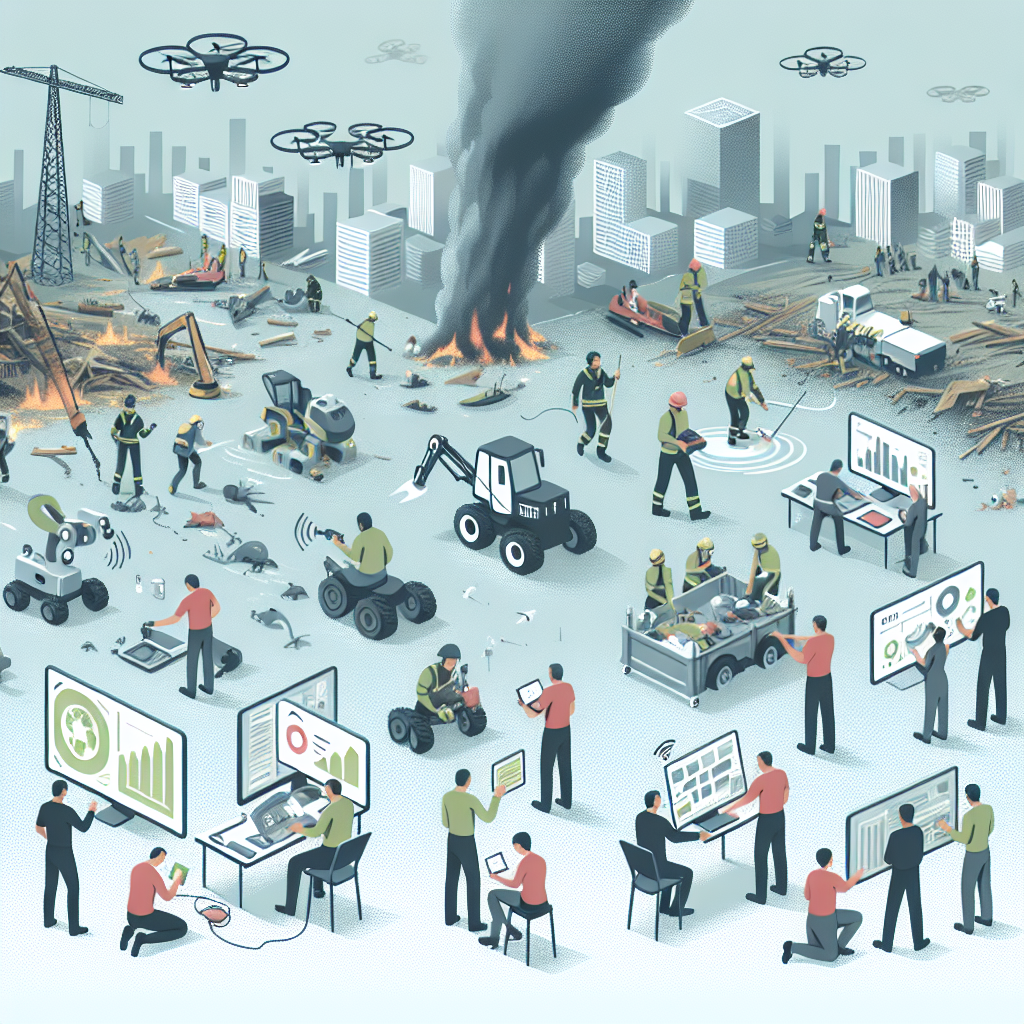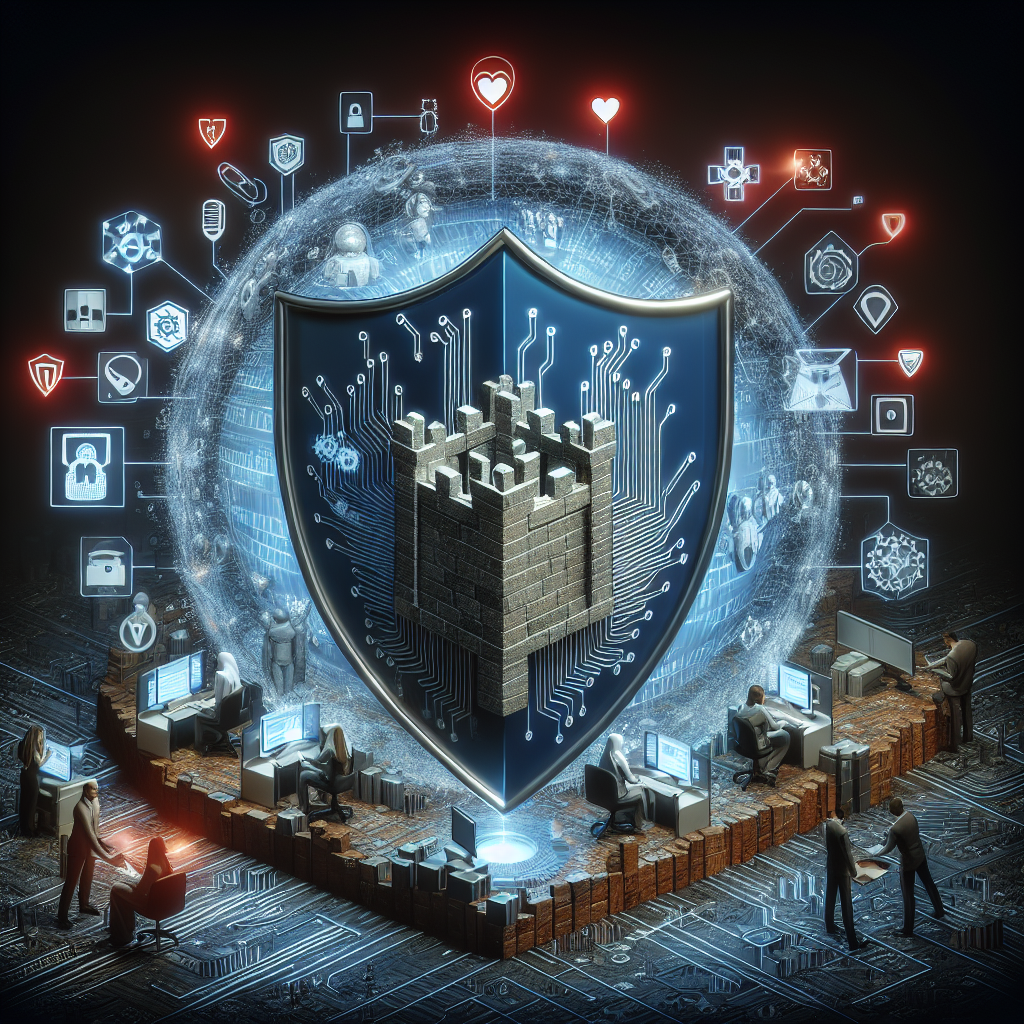Your cart is currently empty!
Tag: Role

The Role of AI and Machine Learning in Modern Technical Support
In today’s fast-paced digital world, the demand for efficient and effective technical support services is higher than ever. With the rapid advancement of technology, businesses are constantly looking for ways to streamline their operations and provide better customer service. One of the key technologies that is revolutionizing the technical support industry is artificial intelligence (AI) and machine learning.AI and machine learning are transforming the way companies provide technical support by automating processes, predicting customer needs, and enhancing the overall user experience. These technologies have the potential to revolutionize the technical support industry by reducing costs, improving efficiency, and increasing customer satisfaction.
One of the key roles of AI and machine learning in modern technical support is automation. By implementing AI-powered chatbots, companies can provide instant and personalized assistance to customers 24/7. These chatbots are equipped with natural language processing capabilities that allow them to understand and respond to customer queries in real-time, without the need for human intervention. This not only speeds up the resolution process but also frees up human agents to focus on more complex issues.
Moreover, AI and machine learning algorithms can analyze vast amounts of data to predict customer behavior and anticipate their needs. By analyzing customer interactions and feedback, companies can proactively address potential issues before they escalate, leading to higher customer satisfaction and loyalty.
Another key role of AI and machine learning in technical support is in the field of predictive maintenance. By analyzing data from connected devices and sensors, companies can predict when equipment is likely to fail and proactively schedule maintenance before a breakdown occurs. This not only reduces downtime and maintenance costs but also improves the overall reliability of the systems.
Additionally, AI-powered analytics tools can help companies gain valuable insights into customer preferences and behaviors, allowing them to tailor their support services to meet individual needs. By leveraging AI and machine learning, companies can provide personalized recommendations, troubleshoot issues more effectively, and deliver a seamless customer experience.
In conclusion, AI and machine learning are playing a crucial role in modern technical support by automating processes, predicting customer needs, and enhancing the overall user experience. By harnessing the power of these technologies, companies can improve efficiency, reduce costs, and increase customer satisfaction. As technology continues to evolve, the role of AI and machine learning in technical support will only become more prominent, revolutionizing the way businesses interact with their customers.

The Role of AI and Machine Learning in Cybersecurity
As technology continues to advance, so do the methods of cyberattacks. In today’s digital age, it has become crucial for organizations to have robust cybersecurity measures in place to protect their sensitive information and data from being compromised. With the rise of artificial intelligence (AI) and machine learning, cybersecurity has been taken to a whole new level.AI and machine learning have revolutionized the way cybersecurity professionals detect and respond to threats. These technologies have the capability to analyze vast amounts of data and identify patterns that may indicate a potential security breach. By learning from past incidents, AI and machine learning algorithms can continuously improve and adapt to new threats, making them extremely effective in preventing cyberattacks.
One of the key roles of AI and machine learning in cybersecurity is in threat detection. Traditional methods of detecting threats involve setting up rules and signatures to identify malicious activity. However, cybercriminals are constantly evolving their tactics, making it difficult for these rules to keep up. AI and machine learning, on the other hand, can detect anomalies in real-time and alert security teams to potential threats before they can cause any harm.
Another important role of AI and machine learning in cybersecurity is in incident response. In the event of a security breach, these technologies can help security teams quickly analyze the situation, determine the extent of the damage, and take appropriate action to mitigate the threat. By automating the incident response process, organizations can minimize the impact of a cyberattack and prevent further damage to their systems.
Furthermore, AI and machine learning can also be used to enhance user authentication and access control. By analyzing user behavior and identifying any suspicious activity, these technologies can help organizations prevent unauthorized access to their systems and data. This is particularly important in today’s remote work environment, where employees are accessing sensitive information from various devices and locations.
Overall, the role of AI and machine learning in cybersecurity is becoming increasingly important as cyber threats continue to evolve. By leveraging these technologies, organizations can improve their security posture, detect and respond to threats more effectively, and ultimately protect their valuable data from falling into the wrong hands. As the cybersecurity landscape continues to evolve, AI and machine learning will play a crucial role in helping organizations stay one step ahead of cybercriminals.

The Role of Technology in Business Continuity: Leveraging Tools and Systems for Seamless Operations
Business continuity is a crucial aspect of any organization, especially in today’s fast-paced and unpredictable business environment. With the increasing reliance on technology in the workplace, it is essential for businesses to leverage tools and systems to ensure seamless operations in times of crisis.Technology plays a significant role in business continuity planning, as it enables organizations to efficiently manage their operations and maintain critical functions during disruptions. By leveraging the right tools and systems, businesses can minimize downtime, reduce risks, and ensure the continuity of their operations.
One of the key ways technology helps in business continuity is by enabling remote work. With the rise of cloud-based tools and systems, employees can work from anywhere, allowing businesses to continue their operations even in times of crisis. This flexibility is crucial for maintaining productivity and ensuring that business processes are not disrupted.
Another way technology aids in business continuity is through the use of communication tools. With the help of technologies like video conferencing, instant messaging, and collaboration platforms, businesses can stay connected with their employees, customers, and stakeholders, even when physical communication is not possible. This ensures that information flows smoothly and critical decisions can be made promptly.
Furthermore, technology enables businesses to create robust disaster recovery plans. By utilizing backup and recovery tools, businesses can protect their data and systems from potential threats and ensure that they can quickly recover in case of a disaster. This proactive approach to data protection is essential for minimizing the impact of disruptions on business operations.
In addition, technology helps businesses automate their processes, reducing the reliance on manual interventions and ensuring that operations run smoothly even during challenging times. By implementing workflow automation tools, businesses can streamline their processes, increase efficiency, and reduce the risk of errors.
Overall, the role of technology in business continuity is undeniable. By leveraging the right tools and systems, businesses can ensure seamless operations, minimize risks, and maintain productivity even in the face of disruptions. It is essential for organizations to invest in technology to build resilience and adaptability, ultimately ensuring their long-term success in today’s ever-changing business landscape.

The Role of Network Management in Ensuring Network Security
Network management plays a crucial role in ensuring network security. With the increasing number of cyber threats and attacks, organizations must prioritize network security to protect their sensitive data and infrastructure. Network management involves monitoring, analyzing, and optimizing a network to ensure its performance and security.One of the key aspects of network management in ensuring network security is monitoring network traffic. By continuously monitoring network traffic, network administrators can detect any unusual or suspicious activities that may indicate a security breach. This allows them to take immediate action to prevent any potential threats from compromising the network.
Another important role of network management in ensuring network security is implementing security measures such as firewalls, intrusion detection systems, and encryption protocols. These security measures help protect the network from unauthorized access, malware, and other cyber threats. Network management also involves regularly updating and patching software and firmware to address any vulnerabilities that could be exploited by hackers.
In addition, network management plays a role in enforcing security policies and access controls. By defining and enforcing security policies, network administrators can ensure that only authorized users have access to sensitive data and resources. Access controls help prevent unauthorized individuals from gaining access to the network and compromising its security.
Furthermore, network management involves conducting regular security audits and assessments to identify any weaknesses in the network security infrastructure. By conducting these audits, network administrators can proactively address any vulnerabilities and strengthen the network’s defenses against potential cyber threats.
Overall, network management plays a critical role in ensuring network security by monitoring network traffic, implementing security measures, enforcing security policies, and conducting regular security audits. By prioritizing network security and investing in effective network management practices, organizations can protect their sensitive data and infrastructure from cyber threats and attacks.

The Role of Technology in Disaster Recovery: Leveraging Tools for Success
Disasters can strike at any time, and the impact they have on businesses can be devastating. From natural disasters like hurricanes and earthquakes to man-made disasters such as cyber-attacks and power outages, organizations must be prepared to respond quickly and effectively to minimize the damage and ensure continuity of operations. This is where technology plays a crucial role in disaster recovery.Technology has revolutionized the way businesses approach disaster recovery, providing them with tools and solutions that can streamline the recovery process and make it more efficient. From cloud computing and virtualization to data backup and recovery solutions, technology has made it easier for organizations to bounce back from disasters and continue their operations without major disruptions.
One of the key benefits of technology in disaster recovery is the ability to automate processes and reduce human error. With the help of tools like data backup and recovery software, organizations can ensure that their critical data is protected and easily accessible in the event of a disaster. This not only speeds up the recovery process but also minimizes the risk of data loss.
Cloud computing has also played a significant role in disaster recovery by providing organizations with a flexible and scalable infrastructure that can be accessed from anywhere. By storing data and applications in the cloud, businesses can ensure that they have access to their critical resources even if their physical infrastructure is compromised.
Virtualization technology is another valuable tool for disaster recovery, allowing organizations to replicate their entire IT environment in a virtual environment. This enables them to quickly switch to a backup system in the event of a disaster, minimizing downtime and ensuring continuity of operations.
In addition to these tools, technology also enables organizations to create and test disaster recovery plans more effectively. By simulating different disaster scenarios and testing their response, businesses can identify and address any weaknesses in their recovery strategy before a real disaster strikes.
Overall, technology has revolutionized the way businesses approach disaster recovery, providing them with the tools and solutions they need to effectively respond to and recover from disasters. By leveraging these tools for success, organizations can ensure that they are prepared for any eventuality and can continue to operate even in the face of adversity.

The Role of a Help Desk in Providing Exceptional Customer Support
Customer support is an essential aspect of any business, as it plays a crucial role in maintaining customer satisfaction and loyalty. One key component of effective customer support is the help desk, which serves as a central point of contact for customers seeking assistance with products or services.The help desk is responsible for responding to customer inquiries, resolving technical issues, and providing guidance on how to use products or services effectively. By serving as a dedicated support team, the help desk plays a vital role in ensuring that customers have a positive experience with a company.
One of the main functions of a help desk is to provide timely and efficient support to customers. This means responding to inquiries promptly and resolving issues in a timely manner. By offering quick and effective solutions, the help desk can help customers overcome any challenges they may be facing and ensure that they are satisfied with their experience.
In addition to resolving technical issues, the help desk also plays a critical role in providing guidance and information to customers. This includes helping customers navigate through products or services, troubleshooting problems, and offering tips on how to use products effectively. By providing clear and helpful guidance, the help desk can empower customers to make the most out of their purchases and enhance their overall experience.
Furthermore, the help desk serves as a valuable source of feedback for a company. By monitoring customer inquiries and concerns, the help desk can identify common issues and trends, which can help the company improve its products or services. Additionally, the help desk can gather valuable insights on customer preferences and expectations, which can inform future product development and marketing strategies.
Overall, the role of a help desk in providing exceptional customer support cannot be overstated. By serving as a dedicated support team, the help desk plays a critical role in ensuring that customers have a positive experience with a company. From resolving technical issues to providing guidance and feedback, the help desk is an invaluable resource for both customers and businesses alike.

The Role of Managed Services in Cybersecurity Protection
In today’s digital age, cybersecurity threats are constantly evolving and becoming more sophisticated. Businesses are increasingly at risk of cyberattacks that can result in data breaches, financial loss, and damage to their reputation. This is where managed services play a crucial role in helping organizations protect themselves from these threats.Managed services refer to the practice of outsourcing the management of certain functions, such as cybersecurity, to a third-party provider. These providers are experts in their field and have the knowledge and resources to effectively protect businesses from cyber threats.
One of the main roles of managed services in cybersecurity protection is to proactively monitor and detect potential threats before they can cause harm. This is done through continuous monitoring of network traffic, analyzing data for unusual patterns, and identifying any vulnerabilities that could be exploited by hackers.
Managed services also play a key role in responding to cyber incidents in a timely and effective manner. In the event of a cyberattack, the provider can quickly isolate the affected systems, contain the threat, and restore normal operations. This can help minimize the impact of the attack and reduce downtime for the business.
Furthermore, managed services can help businesses stay compliant with industry regulations and standards related to cybersecurity. Providers are well-versed in the latest regulations and can ensure that businesses are following best practices to protect their data and systems.
Another important role of managed services in cybersecurity protection is educating employees about cybersecurity best practices. Human error is often a major contributing factor to cyber incidents, so raising awareness and providing training can help prevent these incidents from occurring.
In conclusion, the role of managed services in cybersecurity protection is crucial for businesses to effectively defend against the ever-growing threat of cyberattacks. By outsourcing their cybersecurity needs to a trusted provider, businesses can benefit from expert knowledge, proactive monitoring, rapid incident response, compliance assistance, and employee training. This allows businesses to focus on their core operations while having peace of mind knowing that their data and systems are being protected by professionals.

The Role of Service Level Agreements in Customer Satisfaction and Retention
Service Level Agreements (SLAs) play a crucial role in ensuring customer satisfaction and retention for businesses. An SLA is a formal agreement between a service provider and a customer that outlines the level of service that will be provided, including the quality, availability, and responsiveness of the service.One of the key benefits of SLAs is that they set clear expectations for both parties. By clearly defining the scope of services, response times, and performance metrics, SLAs help to establish a common understanding of what is expected from the service provider. This transparency helps to build trust between the provider and the customer, which is essential for maintaining a strong and long-lasting relationship.
Moreover, SLAs help to ensure consistent and high-quality service delivery. By setting specific targets and benchmarks for performance, SLAs provide a framework for measuring and monitoring the service provider’s performance. This helps to identify any potential issues or gaps in service delivery early on, allowing for timely intervention and resolution. Consistent and reliable service delivery is a key factor in customer satisfaction, as customers are more likely to trust and continue doing business with providers who consistently meet or exceed their expectations.
In addition, SLAs can also help to improve communication and collaboration between the service provider and the customer. By clearly defining roles and responsibilities, as well as establishing channels for communication and escalation of issues, SLAs facilitate a more efficient and effective working relationship. This can help to prevent misunderstandings or conflicts, and ensure that any issues that arise are addressed and resolved promptly.
Overall, the role of SLAs in customer satisfaction and retention cannot be overstated. By setting clear expectations, ensuring consistent service delivery, and facilitating effective communication, SLAs help to build trust, enhance customer experience, and ultimately drive customer loyalty. Businesses that prioritize the implementation and management of SLAs are more likely to succeed in today’s competitive marketplace and retain their valuable customers for the long term.

The Role of Data Backup and Recovery in Maintaining Business Continuity
Data is the lifeblood of any modern business. From customer information to financial records, data plays a crucial role in day-to-day operations and decision-making. However, data is vulnerable to a variety of threats, including hardware failure, human error, cyberattacks, and natural disasters. Without a reliable backup and recovery plan in place, businesses risk losing valuable data and experiencing significant downtime, which can have a devastating impact on their operations.Data backup and recovery are essential components of maintaining business continuity. Backup refers to the process of creating copies of data and storing them in a separate location, while recovery involves restoring data from these backups in the event of a data loss incident. By regularly backing up data and having a solid recovery plan in place, businesses can minimize the risk of data loss and ensure that they can quickly recover from any disruptions.
There are several key reasons why data backup and recovery are crucial for maintaining business continuity. Firstly, data loss can have serious financial implications for a business. According to a study by the Ponemon Institute, the average cost of a data breach in 2020 was $3.86 million. By having a robust backup and recovery plan in place, businesses can avoid costly downtime and potential loss of revenue.
Secondly, data backup and recovery are essential for maintaining customer trust and loyalty. In today’s digital age, customers expect businesses to protect their personal information and ensure that it is secure. A data breach or loss can erode customer trust and damage a business’s reputation. By safeguarding data through regular backups and quick recovery processes, businesses can demonstrate their commitment to data security and build trust with their customers.
Furthermore, data backup and recovery can help businesses comply with regulatory requirements. Many industries have strict regulations governing the protection of sensitive data, such as the Health Insurance Portability and Accountability Act (HIPAA) in the healthcare sector and the General Data Protection Regulation (GDPR) in the European Union. By implementing a comprehensive backup and recovery plan, businesses can ensure that they are in compliance with these regulations and avoid potential fines and penalties.
In conclusion, data backup and recovery play a critical role in maintaining business continuity. By safeguarding data, businesses can minimize the risk of data loss, protect their finances, maintain customer trust, and comply with regulatory requirements. Investing in a reliable backup and recovery solution is essential for any business looking to protect its valuable data and ensure that it can quickly recover from any disruptions.

The Role of Remote Monitoring in Managing Chronic Conditions
Remote monitoring technology is revolutionizing the way healthcare providers manage chronic conditions. By allowing patients to track their vital signs and symptoms from the comfort of their own homes, remote monitoring has the potential to improve outcomes, reduce hospitalizations, and lower healthcare costs.Chronic conditions such as diabetes, heart disease, and hypertension require ongoing management and monitoring to prevent complications and optimize health. Traditionally, patients with these conditions would need to visit their healthcare provider regularly for check-ups and monitoring. However, this can be time-consuming and inconvenient for both the patient and the provider.
Remote monitoring technology allows patients to take control of their own health by tracking their vital signs, such as blood pressure, blood sugar levels, and heart rate, using devices such as wearable sensors, smart scales, and smartphone apps. This data is then sent to their healthcare provider in real-time, allowing for early intervention if any abnormalities are detected.
The benefits of remote monitoring in managing chronic conditions are clear. Patients can receive more personalized and timely care, as their healthcare provider can monitor their condition on a continuous basis and make adjustments to their treatment plan as needed. This can lead to better outcomes, such as improved blood sugar control in diabetics or reduced blood pressure in hypertensive patients.
Remote monitoring also has the potential to reduce hospitalizations and emergency room visits. By detecting changes in a patient’s condition early on, healthcare providers can intervene before a serious complication occurs, preventing the need for costly hospitalizations and emergency treatments.
In addition, remote monitoring can help to lower healthcare costs by reducing the need for frequent office visits and unnecessary tests. By monitoring patients remotely, healthcare providers can focus their resources on patients who truly need in-person care, leading to more efficient and cost-effective healthcare delivery.
Overall, remote monitoring technology is playing an increasingly important role in managing chronic conditions. By empowering patients to take control of their own health and providing healthcare providers with real-time data on their patients’ conditions, remote monitoring has the potential to improve outcomes, reduce hospitalizations, and lower healthcare costs. As technology continues to advance, the role of remote monitoring in managing chronic conditions will only continue to grow.
